Rapid and acute effects of estrogen on time perception in male and female rats
- PMID: 22016725
- PMCID: PMC3192991
- DOI: 10.3389/fnint.2011.00063
Rapid and acute effects of estrogen on time perception in male and female rats
Abstract
Sex differences in the rapid and acute effects of estradiol on time perception were investigated in adult male and female Sprague-Dawley rats. Because estradiol has been shown to increase striatal dopamine release, it may be able to modify time perception and timed performance by increasing the speed of an internal clock in a manner similar to indirect dopamine agonists such as amphetamine and cocaine. Two groups of females (neonatally estradiol-treated/adult ovariectomized and neonatally oil-treated/adult ovariectomized) and two groups of males (neonatally castrated and adult castrated) were trained in a 2 vs. 8-s duration bisection procedure and tested using intermediate signal durations. After obtaining oil-injected baseline psychometric functions over several days, rats were administered 5 μg of estradiol for 4 days and behaviorally evaluated 30 min following each injection. This oil-estradiol administration cycle was subsequently repeated three times following the re-establishment of baseline training. Results revealed significant sex differences in the initial baseline functions that were not modifiable by organizational hormones, with males' duration bisection functions shifted horizontally to the left of females'. Upon the first administration of estradiol, females, but not males, showed a significant, transient leftward shift in their bisection functions, indicative of an increase in clock speed. After extensive retraining in the duration bisection procedure, rats that were exposed to gonadal hormones during the first week of life showed a significant rightward shift in their bisection functions on the fourth day of estradiol administration during each cycle, suggesting a decrease in clock speed. Taken together, our results support the view that there are multiple mechanisms of estrogens' action in the striatum that modulate dopaminergic activity and are differentially organized by gonadal steroids during early brain development.
Keywords: clock speed; dopamine; duration bisection; interval timing; sex differences; striatum.
Figures
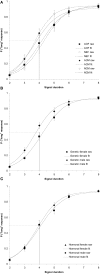
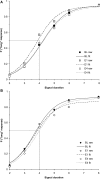
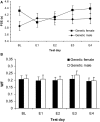

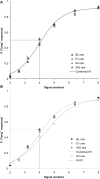
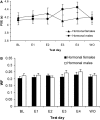
Similar articles
-
Estradiol modulation of the speed of an internal clock.Behav Neurosci. 2007 Apr;121(2):422-32. doi: 10.1037/0735-7044.121.2.422. Behav Neurosci. 2007. PMID: 17469932
-
Rapid effects of estrogen or progesterone on the amphetamine-induced increase in striatal dopamine are enhanced by estrogen priming: a microdialysis study.Pharmacol Biochem Behav. 1999 Sep;64(1):53-7. doi: 10.1016/s0091-3057(99)00091-x. Pharmacol Biochem Behav. 1999. PMID: 10494997
-
Differential effects of cocaine and ketamine on time estimation: implications for neurobiological models of interval timing.Pharmacol Biochem Behav. 2006 Sep;85(1):114-22. doi: 10.1016/j.pbb.2006.07.019. Epub 2006 Aug 21. Pharmacol Biochem Behav. 2006. PMID: 16920182
-
Ketamine "unlocks" the reduced clock-speed effects of cocaine following extended training: evidence for dopamine--glutamate interactions in timing and time perception.Neurobiol Learn Mem. 2007 Sep;88(2):149-59. doi: 10.1016/j.nlm.2007.04.005. Epub 2007 May 21. Neurobiol Learn Mem. 2007. PMID: 17513138
-
Rapid effects of ovarian hormones in dorsal striatum and nucleus accumbens.Horm Behav. 2018 Aug;104:119-129. doi: 10.1016/j.yhbeh.2018.04.002. Epub 2018 Apr 22. Horm Behav. 2018. PMID: 29626485 Free PMC article. Review.
Cited by
-
Acquisition of "Start" and "Stop" response thresholds in peak-interval timing is differentially sensitive to protein synthesis inhibition in the dorsal and ventral striatum.Front Integr Neurosci. 2012 Mar 14;6:10. doi: 10.3389/fnint.2012.00010. eCollection 2012. Front Integr Neurosci. 2012. PMID: 22435054 Free PMC article.
-
Analysis of Genetic and Non-Genetic Factors Influencing Timing and Time Perception.PLoS One. 2015 Dec 7;10(12):e0143873. doi: 10.1371/journal.pone.0143873. eCollection 2015. PLoS One. 2015. PMID: 26641268 Free PMC article.
-
Isolating the delay component of impulsive choice in adolescent rats.Front Integr Neurosci. 2014 Jan 27;8:3. doi: 10.3389/fnint.2014.00003. eCollection 2014. Front Integr Neurosci. 2014. PMID: 24478644 Free PMC article.
-
Ovarian cycle effects on immediate reward selection bias in humans: a role for estradiol.J Neurosci. 2014 Apr 16;34(16):5468-76. doi: 10.1523/JNEUROSCI.0014-14.2014. J Neurosci. 2014. PMID: 24741037 Free PMC article.
-
Effect of Exercise-Related Factors on the Perception of Time.Front Physiol. 2020 Jul 6;11:770. doi: 10.3389/fphys.2020.00770. eCollection 2020. Front Physiol. 2020. PMID: 32733275 Free PMC article. Review.
References
-
- Allen L. G., Gibbon J. (1991). Human bisection at the geometric mean. Learn. Motiv. 22, 39–5810.1016/0023-9690(91)90016-2 - DOI
-
- Anderson J. C., Williams S., McGee R., Silva P. A. (1987). DSM-III disorders in preadolescent children: prevalence in a large sample from the general population. Arch. Gen. Psychiatry 44, 69–76 - PubMed
LinkOut - more resources
Full Text Sources

